Contents
- Physical Features
- Climate
- Geology
- Soil
- Minerals
- Rivers
- Botany
- Wild Animals
- Birds
- Fishes
- Forest Reserves
- Gautala Autramghat Sanctuary
- Land Use
- Environmental Concerns
- Water Scarcity
- Industrial Pollution
- Deforestation
- Waste Management
- Conservation Efforts/Protests
- Protests over Floating Solar Panels
- Water Protests in Marathwada
- Environmental NGOs
- Graphs
- Water
- A. Rainfall (Yearly)
- B. Rainfall (Monthly)
- C. Evapotranspiration Potential vs Actual Numbers (Yearly)
- D. Annual Runoff
- E. Runoff (Monthly)
- F. Soil Moisture (Yearly)
- G. Seasonal Groundwater Levels: Bore Wells
- H. Seasonal Groundwater Levels: Dug Wells
- Climate & Atmosphere
- A. Maximum Temperature (Yearly)
- B. Maximum Temperature (Monthly)
- C. Minimum Temperature (Yearly)
- D. Minimum Temperature (Monthly)
- E. Wind Speed (Yearly)
- F. Wind Speed (Monthly)
- G. Relative Humidity
- Human Footprint
- A. Nighttime Lights
- Sources
CHH. SAMBHAJI NAGAR
Environment
Last updated on 6 November 2025. Help us improve the information on this page by clicking on suggest edits or writing to us.
Chhatrapati Sambhaji Nagar, a significant district in Maharashtra, is marked by a semi-arid climate and a varied ecological landscape that includes hills, plateaus, and the notable Gautala Autramghat Wildlife Sanctuary. Despite its rich biodiversity, the region has faced substantial environmental challenges due to rapid urbanization, industrial growth, and agricultural development.
Physical Features
The Gazetteer of Aurangabad, published in 1884, provides a detailed account of the Chhatrapati Sambhaji Nagar district's geography, history, and socio-economic conditions during that period. As per the same, the district is characterized by a distinct division into Uplands in the north and Lowlands in the south, particularly in the valley of the Godavari. This natural division reflects similarities with the assigned districts of Berar, drawing parallels to the Balaghat and Paianghat sections found in that province. The Balaghat serves as a continuation of the highland region from Chhatrapati Sambhaji Nagar and Kanhar, while the Paianghat corresponds to the fertile lowlands of the Godavari valley.
Climate
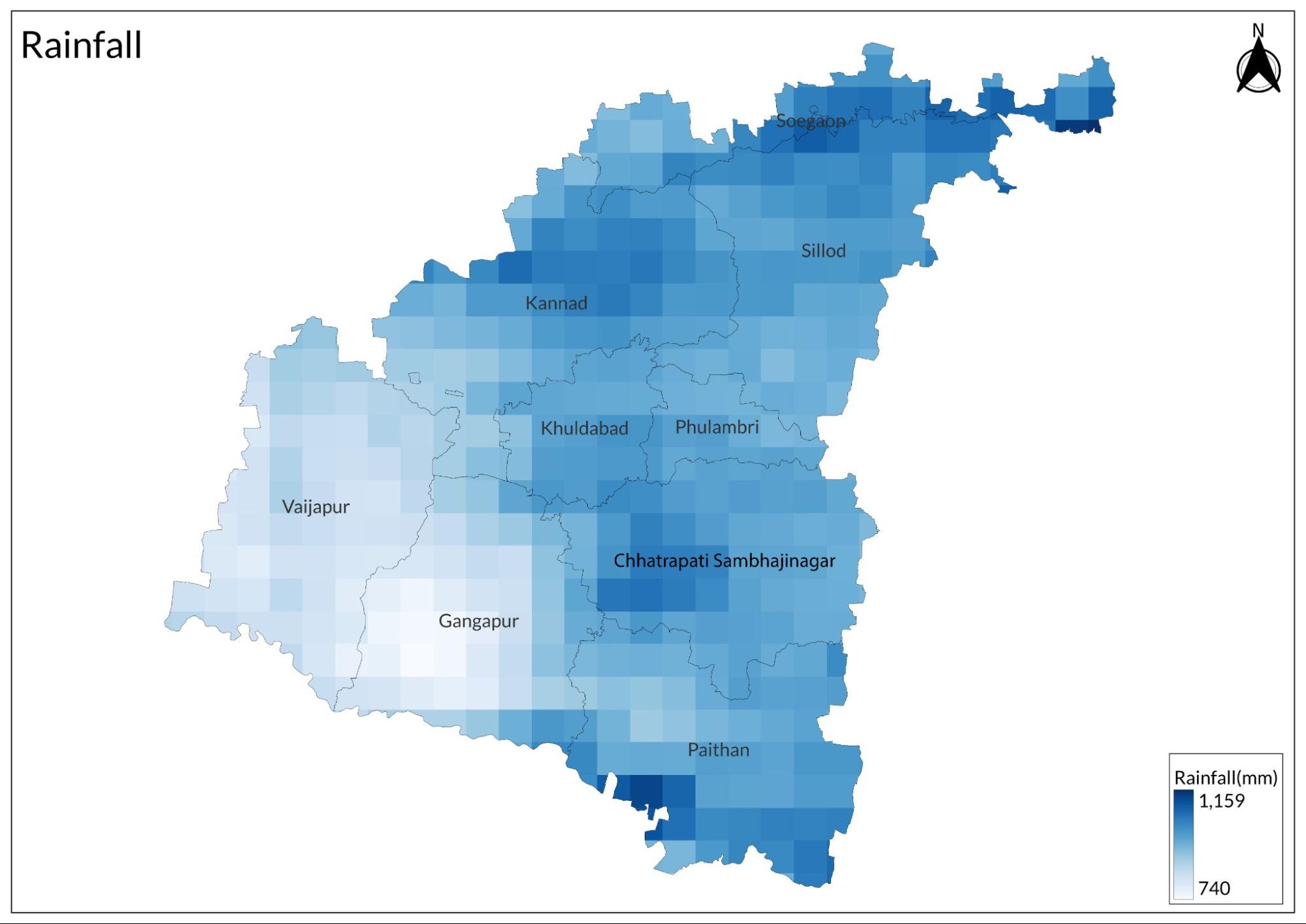
The climate of Chhatrapati Sambhaji Nagar is influenced by a variety of factors, including its distance from the sea, the characteristics of the surrounding terrain, the distribution of land and water, the direction of mountain chains, its altitude above sea level, and the nature of its soil and vegetation. Additionally, the effects of subaerial decomposition and denudation significantly impact the form and productivity of the land surface, which are largely dependent on atmospheric influences. However, Chhatrapati Sambhaji Nagar is not an isolated region with distinct climatic peculiarities; rather, it is part of the larger area of Western India, which experiences similar meteorological conditions. At the same time, the district may be subject to numerous local variations; thus, when generalizing about its climate, it is essential to consider observations from larger areas of which it is an integral part.

Chhatrapati Sambhaji Nagar generally experiences a tropical climate with an average annual temperature of around 26°C. The temperature varies throughout the year: in winter (December), it can drop to a minimum of approximately 12.5°C, while in summer (May), it may rise to a maximum of about 40°C.
Geology
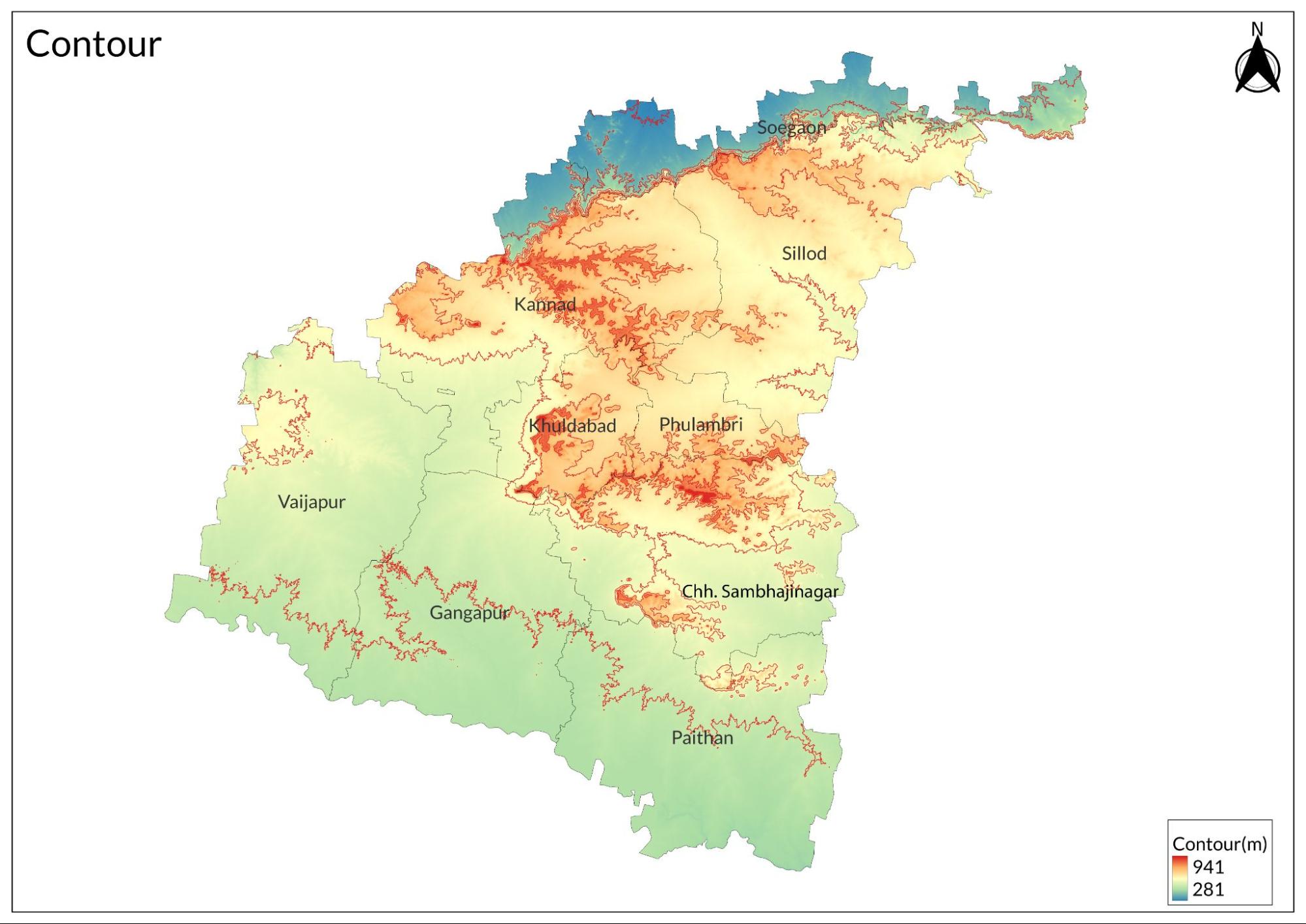
According to the Records and Memoirs of the Geological Survey of the Government of India, the geological formations in the Chhatrapati Sambhaji Nagar district, starting from the lowest, include the Middle Traps of the Dakhan Tertiary, followed by the Older Alluvial Deposits of the Godavari, and finally, the Modern Alluvial Deposits of the Godavari and other rivers. The area is predominantly covered by the Deccan Traps, which consist of basaltic lava flows from the Upper Cretaceous to Lower Eocene age. These lava flows are characterized by horizontal layering, with distinct units that include vesicular and amygdaloidal zeolitic basalt in the upper layers and massive basalt at the bottom.
The basaltic lava flows are the only major geological formation occurring in Chhatrapati Sambhaji Nagar and play a crucial role in groundwater storage and transmission, with their varying porosity and permeability affecting water yield. Additionally, thin alluvial deposits can be found along the Kham and Sukhana rivers, contributing to the region's geological diversity. Groundwater occurs under unconfined conditions in shallow aquifers and is mainly controlled by secondary porosity features such as joints and fractures.
Soil
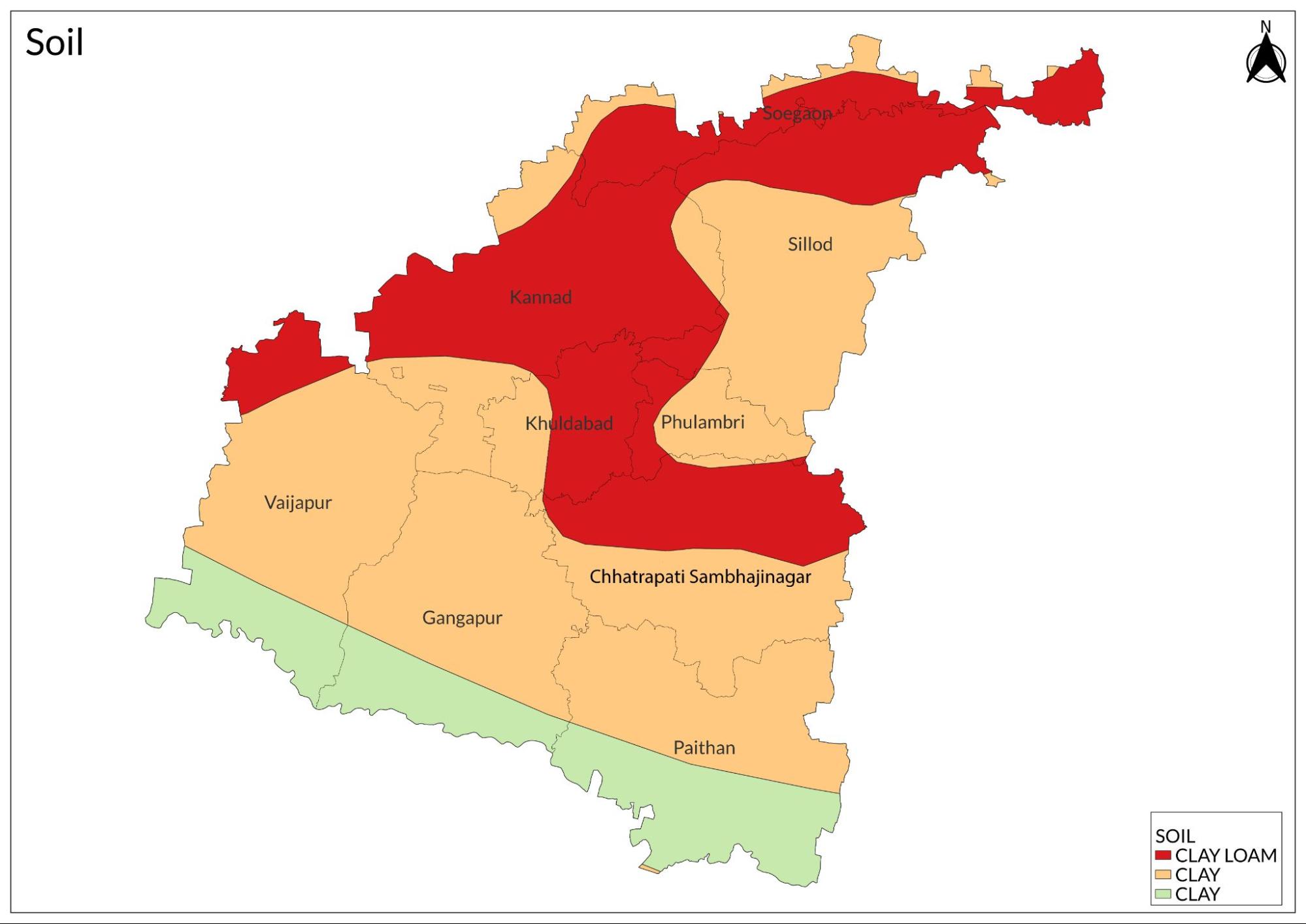
Minerals
The notable minerals found in the region include agate stones, which are utilized for manufacturing decorative items such as paperweights, pendants, and buttons. Additionally, the district has deposits of bauxite, the primary ore for aluminum production, although its significant occurrences are more prominent in other districts of Maharashtra.
Rivers
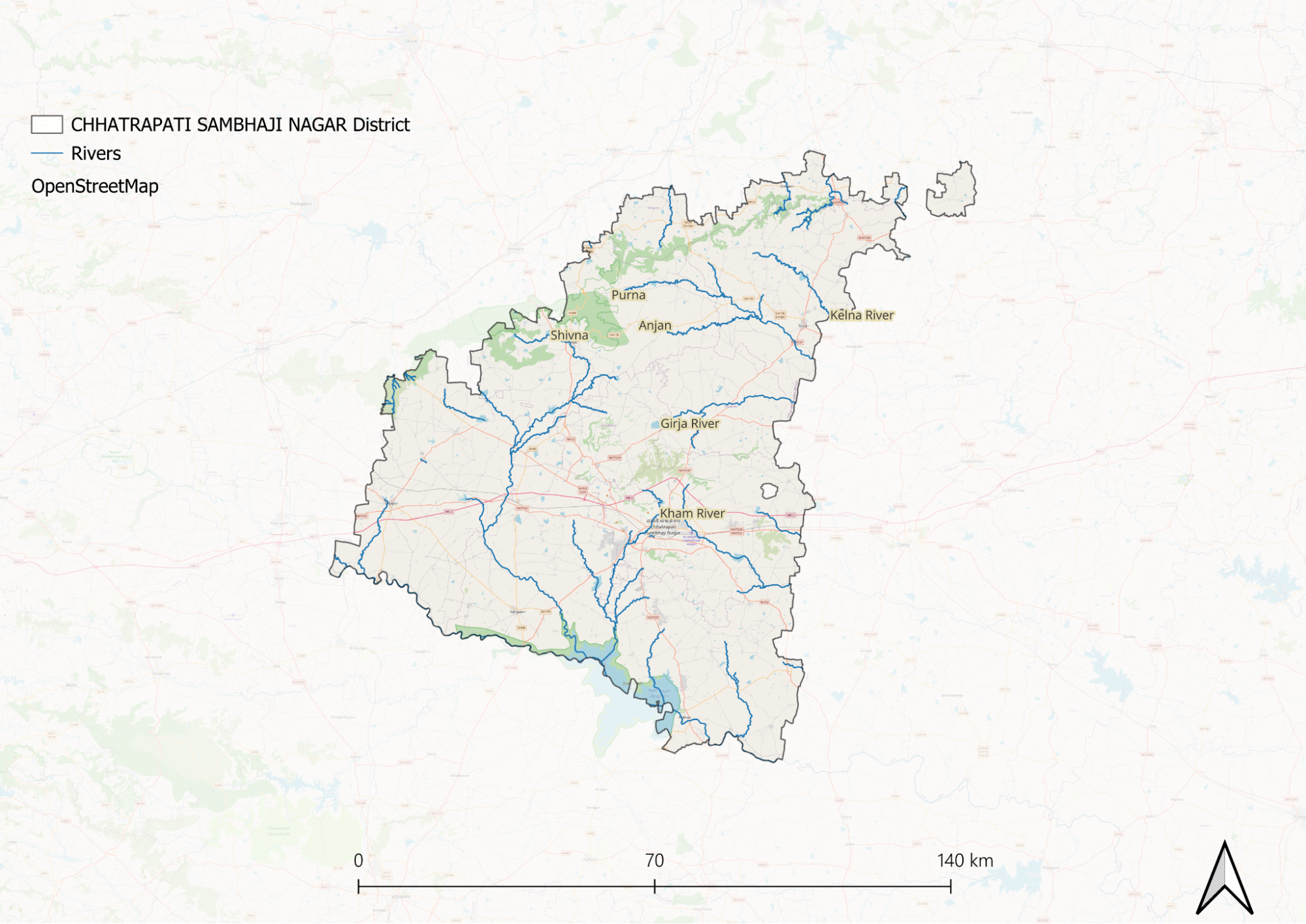
Except for a very small portion of the country beyond the Ajanta and Gaotala Ghats, which belongs to the valley of the Tapti, the district is drained by the Godavari and its tributaries to the north. Therefore, an enumeration of the principal feeders of the river will comprise almost the entire river system of the district.
Botany
The flora of Chhatrapati Sambhaji Nagar district is characterized by a rich diversity of plant species, both indigenous and naturalized. The region hosts various plant families that contribute to its ecological richness. Among the notable species, "moriel" can be found in the ghat jungles. The Annonaceae family, custard apple, which often grows wild near villages, and Polyalthia longifolia, is sometimes planted in gardens and avenues.
Another species, diar, is also prevalent in hedges and is used in traditional medicine. The water lily family features aquatic plants like kangwel and rakta-kamal, which thrive in local tanks. The poppy family includes Feringi Datura, a common plant used in medicine. Other families present in the district include the caper family, with species such as karu found in waste places, and the mallow family, which features plants like pitari, known for its strong fiber. Many of these plants have traditional medicinal uses, such as the roots of gunch, which serve as a substitute for licorice. The bark of kavit is known for its gum, while various species of Ziziphus, like bhair, are utilised for their medicinal properties.
Wild Animals
The Chhatrapati Sambhaji Nagar district's fauna is shaped by its dry zone climate, featuring a mix of common Indian species and unique local varieties. The region primarily supports a semi-African fauna, with occasional Malayan forms found in the jungles adjacent to the Western Ghats, alongside some desert species in the plains.
The invertebrate population includes various subkingdoms, such as Protozoa and Coelenterata, predominantly aquatic, with freshwater polyps being a notable representative.
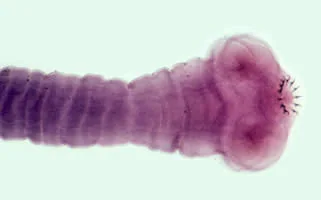
Freshwater shrimp and crayfish, and various arachnids, including spiders and scorpions, share many species with regions like Arabia and Egypt.
Birds
The insect diversity is largely tropical, although some temperate genera are present. Beneficial insects such as silkworms and honeybees coexist with harmful pests that threaten agriculture. Notably, locusts have historically caused significant damage to crops in the area. Insects play dual roles in the ecosystem; while many are beneficial scavengers or predators of harmful species, others are destructive to vegetation, particularly during their larval stages. The grapevines in Chhatrapati Sambhaji Nagar have faced severe threats from pests like Phylloxera, alongside swarms of locusts that have devastated local agriculture. Birds such as woodpeckers help control insect populations, illustrating the complex ecological interactions within this district's environment.
Fishes
Forest Reserves
Gautala Autramghat Sanctuary
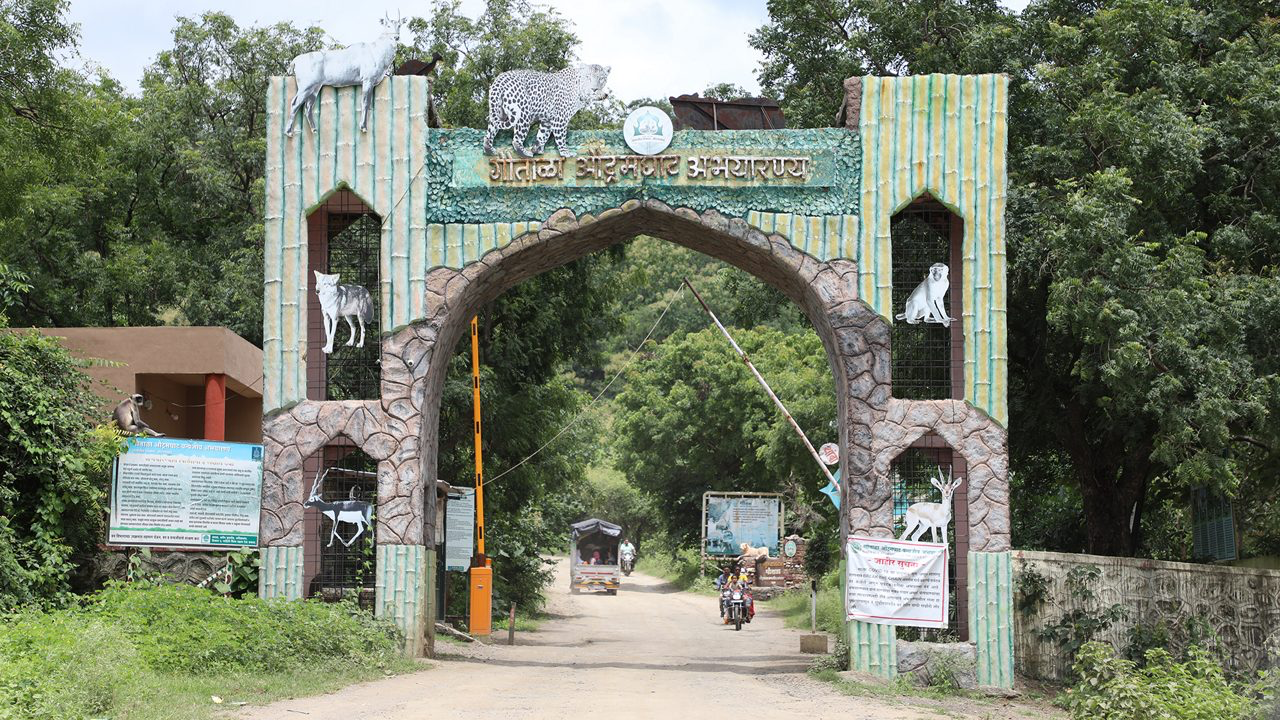
The sanctuary is home to a wide variety of wildlife, including over 240 bird species such as cranes, spoonbills, and peafowls. Mammals like chinkara, nilgai, sloth bears, leopards, and various deer species also inhabit the area. The landscape consists mainly of dry deciduous forests mixed with grasslands.
In addition to its wildlife, Gautala Autramghat Sanctuary features ancient temples, caves, lakes, and waterfalls that attract many visitors. It is easily accessible by road, located about 75 km from Chhatrapati Sambhaji Nagar and 40 km from Chalisgaon. The nearest railway station is Chalisgaon, while Chhatrapati Sambhaji Nagar has the closest airport.
The Maharashtra State Forest Department manages conservation efforts in the sanctuary to protect its diverse plants and animals. This sanctuary plays an important role in wildlife conservation and serves as a valuable site for ecological research and ecotourism in the region.
Land Use
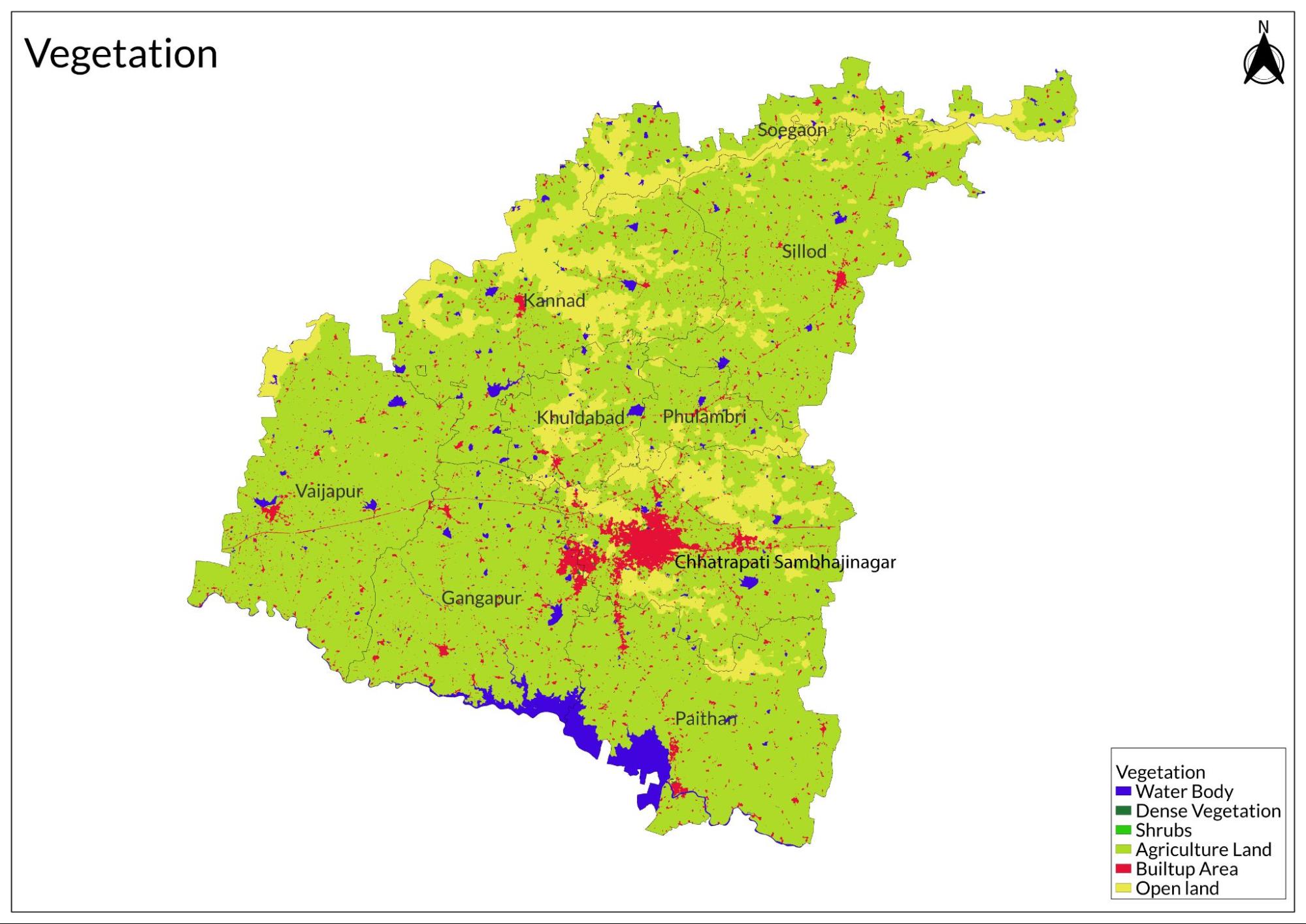
Environmental Concerns
Water Scarcity
In 2022, Chhatrapati Sambhaji Nagar, a significant urban center in Maharashtra, faced a severe water scarcity crisis that had been escalating for two decades. The situation became so dire that residents reported receiving a water supply only once every eight days in certain areas. This chronic shortage was exacerbated by a heatwave affecting much of South Asia, compounding the difficulties faced by the local population.
The water crisis not only impacted daily life but also posed challenges for local industries. Manufacturing processes in power plants were halted due to the lack of water, highlighting the crisis's broader economic implications. Amidst these hardships, citizens took to the streets to protest against the local administration, primarily blaming the ruling Shiv Sena party, which had governed the Municipal Corporation for the past thirty years, often in alliance with the BJP.
Protests intensified throughout May 2022, particularly on May 14, when residents from Pundalik Nagar demonstrated their frustration by climbing atop a public water tank. The BJP organised a significant rally called the "Jal Akrosh Morcha" on May 23, led by Maharashtra Opposition leader Devendra Fadnavis and other party officials. Participants carried empty water containers as a symbolic gesture of dissent against the government's failure to address the water crisis.
The root causes of Chhatrapati Sambhaji Nagar's water issues included inadequate infrastructure to draw water from the nearby Jayakwadi reservoir. Although plans were proposed in 2005 to upgrade the city's water pipelines, these projects were never realised. A collaborative initiative between the BJP and the Shiv Sena aimed at a substantial Rs 1680-crore water project was ultimately derailed by political disagreements and was scrapped when Uddhav Thackeray took office as Chief Minister.
Industrial Pollution
As of early 2020, approximately 1,496 firms in the region were under scrutiny for violating pollution control norms. This scrutiny was part of a broader initiative by the Maharashtra Pollution Control Board (MPCB) to address environmental concerns and ensure compliance with regulatory standards.
The industries in Chhatrapati Sambhaji Nagar, which include manufacturing and processing units, have been identified as major contributors to air and water pollution. The MPCB's investigations revealed that many of these firms had not implemented adequate measures to mitigate their environmental impact. This lack of compliance posed serious risks to both public health and the local ecosystem.
Deforestation
Deforestation in Chhatrapati Sambhaji Nagar district, Maharashtra, has resulted in significant biodiversity loss, disrupting the region's ecological balance. As of 2010, the district had less than 0.1% of its land covered by trees, highlighting a critical lack of forest cover. The forests that do exist primarily consist of species such as teak, sandalwood, anjan, moh, tembhurni, and ain trees.
The total forest area in Chhatrapati Sambhaji Nagar is approximately 568 square kilometers, which includes only 20 square kilometers classified as very dense forest and 106.26 square kilometers as moderately dense forest. The remaining area is categorized as open forest, which is less effective in supporting diverse wildlife.
Waste Management
In 2018, Chhatrapati Sambhaji Nagar faced a serious waste management crisis, with tons of solid waste left to decompose in the open. The Chhatrapati Sambhaji Nagar Municipal Corporation (AMC) struggled to find alternative dumping sites after the residents of Mandki village, where waste had been dumped for over three decades, successfully blocked garbage trucks from entering their area due to a Bombay High Court order prohibiting further dumping.
The AMC sought permission from surrounding villages to dispose of waste, but encountered strong opposition. Villagers even took drastic measures, such as digging up roads to prevent access. Tensions escalated when residents of Padegaon-Mitmita village set fire to AMC trucks attempting to dump waste, leading to clashes with police.
Despite the civic agency's efforts, the situation remained unresolved. The AMC's municipal commissioner expressed frustration over the lack of cooperation from villagers, who were concerned about the environmental and health impacts of the ongoing waste dumping. For years, Mandki residents had protested against the waste site on their grazing land, citing severe groundwater contamination and health issues linked to the dumpsite.
Historically, Chhatrapati Sambhaji Nagar generated around 436 tonnes of solid waste daily. The city had shifted its dumping practices multiple times since the 1980s, ultimately leading to the establishment of the Mandki site in 1985. However, the unsegregated waste disposal practices continued for decades without any treatment or processing, resulting in significant environmental degradation.
Despite previous assurances from the AMC to address the waste issue, little progress was made. Villagers filed multiple public interest litigations in court, seeking closure of the dumpsite. In early 2018, a court ruling prohibited further dumping at Mandki, exacerbating the waste crisis as garbage accumulated across Chhatrapati Sambhaji Nagar.
The AMC challenged this ruling and sought relief from higher courts while attempting to devise a time-bound action plan for improved waste management. This plan included immediate segregation and composting initiatives and aimed to establish a waste-to-energy plant.
Conservation Efforts/Protests
Protests over Floating Solar Panels
In Chhatrapati Sambhaji Nagar, the proposed floating solar project on the Nathsagar reservoir has sparked significant opposition from the local fishing community, particularly around Jayakwadi Dam. Fishermen like Nitin Birute express deep concern that the installation of solar panels could jeopardize their livelihoods and disrupt the delicate aquatic ecosystem they rely on. With around 25,000 families depending on fishing in this area, the potential ecological impact of the solar farm is a pressing issue.
The government views floating photovoltaics as a crucial component of India's clean energy strategy, aiming for net-zero emissions by 2070. However, local fishers argue that the benefits of renewable energy should not come at the cost of their centuries-old way of life. Activists like Bajrang Limbore emphasize that while clean energy is essential, it should not threaten the survival of communities that depend on fishing.
Despite an environmental court ruling allowing the project to proceed, protests have erupted, with some fishermen pursuing legal action to halt construction. They argue that the project poses risks to both their livelihoods and the local ecosystem, which supports diverse wildlife and fish species. Environmentalists warn that blocking sunlight with solar panels could disrupt the food chain within the reservoir.
Water Protests in Marathwada
In early 2023, Marathwada faced significant unrest as various groups prepared for mass protests due to the delayed release of water for the Jayakwadi dam. The Marathwada Pani Parishad (MPP), representing water rights activists and farmers, organized a morcha at the Godavari Marathwada Irrigation Development Corporation (GMIDC) office. Activist Narhari Shivpure emphasized that the community could no longer tolerate the government's perceived injustices regarding water distribution, framing it as a critical moment for action.
Despite an official order from October 30, which mandated the release of 8.6 TMC of water for the dam, no water had been released by the time protests were planned. Local representatives, including Congress MLA Suresh Warpudkar, criticised the government for not providing the expected 13.5 TMC of water. The situation was further complicated by allegations of political interference in the water release process.
As tensions rose, leaders from Parbhani and surrounding areas announced their intent to escalate protests to demand immediate action. Although GMIDC officials acknowledged the order for water release, they cited ongoing delays attributed to awaiting approval from the state government. Local BJP MLA Atul Save reassured constituents that their share of water would be allocated soon, indicating ongoing communication with Deputy Chief Minister Devendra Fadnavis.
The protests highlighted deep-seated frustrations over water scarcity in Marathwada.
Environmental NGOs
Environmental organizations in the Chhatrapati Sambhaji Nagar district play a crucial role in addressing the region's pressing ecological issues, which have arisen from rapid urbanization, industrial growth, and agricultural expansion. These organizations are actively involved in various initiatives aimed at mitigating environmental degradation and promoting sustainable practices.
AFPRO: This organization is involved in water conservation and groundwater recharge projects, aiming to enhance the availability of clean water in the district.
Ekatmik Paryavaran Samiti: Focused on water conservation, this group works with local communities to address water scarcity through tree plantation initiatives and other eco-friendly practices.
Grow Billion Trees Foundation: This foundation aims to plant a billion trees to combat climate change and restore ecosystems, contributing significantly to reforestation efforts in the region.
Kham River Restoration Project: This initiative includes creating a Riverfront EcoPark and implementing upstream interventions to restore the Kham River, highlighting the importance of river conservation.
Marathwada Environmental Care Cluster (MECC): MECC is dedicated to reducing industrial pollution in the Waluj area by promoting cleaner technologies and better waste management practices. Their efforts aim to combat air and water pollution resulting from industrial activities.
Marathwada Gramin Vikas Sanstha (MGVS): MGVS works on integrated watershed development projects that strengthen drinking water sources, focusing on sustainable water management practices.
MGM’s Centre for Human Rights and Environment:This organization focuses on sustainable development and environmental education. It advocates for the protection of the environment while raising awareness about human rights issues related to ecological concerns.
Paryavaran Sanrakshan Samiti: This NGO is involved in raising environmental awareness and organizing clean-up drives. They encourage sustainable practices in both agriculture and industry, fostering a community-oriented approach to environmental protection.
Prayas Youth Foundation: This organization engages in creating water bodies such as trenches, check dams, and small ponds to conserve water and improve soil health, addressing critical water scarcity issues.
Graphs
Water
Climate & Atmosphere
Human Footprint
Sources
Government of Maharashtra. 1960 (Reprinted in 2003). Gazetteers of the Bombay Presidency: Aurangabad District. Maharashtra Gazetteers, Mumbai.https://gazetteers.maharashtra.gov.in/cultur…
Nidhi Jamwal. 2018. Why Aurangabad's Garbage Crisis is Raising a Stink. The Wire, March 28.https://thewire.in/environment/raising-a-sti…
OpIndia. 2022. Water Comes to the Taps Once in Eight Days: BJP to Protest Severe Water Crisis in Maharashtra's Aurangabad. OpIndia.https://www.opindia.com/2022/05/water-comes-…
The Hindu. 2020. 1,496 Firms in Aurangabad Under Scanner for Pollution. The Hindu, January 15.https://www.thehindu.com/news/national/other…
Times of India. 2020. Aurangabad District's Forest Cover Drops by Over 2%.Times of India, December 5.https://timesofindia.indiatimes.com/city/aur…
Times of India. 2023. Water Protests Likely to Escalate in MWADA, Aurangabad. Times of India, October 7.https://timesofindia.indiatimes.com/city/aur…
Wikipedia. Gautala Autramghat Sanctuary. Wikipedia.https://en.wikipedia.org/wiki/Gautala_Autram…
Yash Sadhak Shrivastava. 2024. India's Floating Solar Plans Run into Opposition from Fishers. Context News, November 27.https://www.context.news/just-transition/ind…
Last updated on 6 November 2025. Help us improve the information on this page by clicking on suggest edits or writing to us.